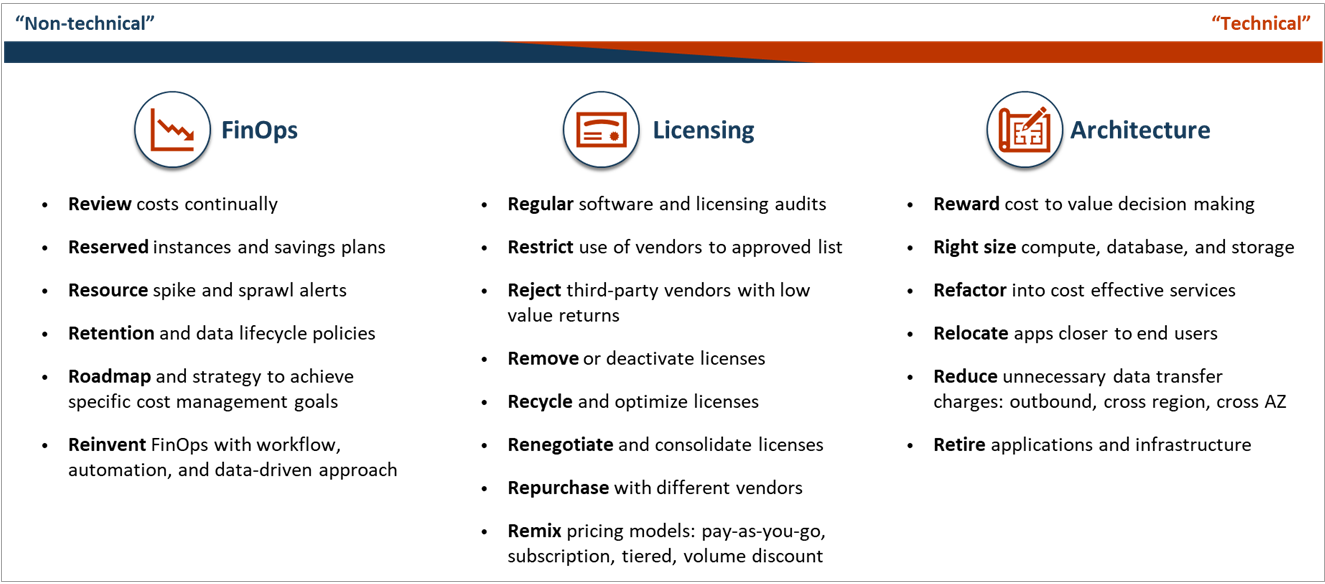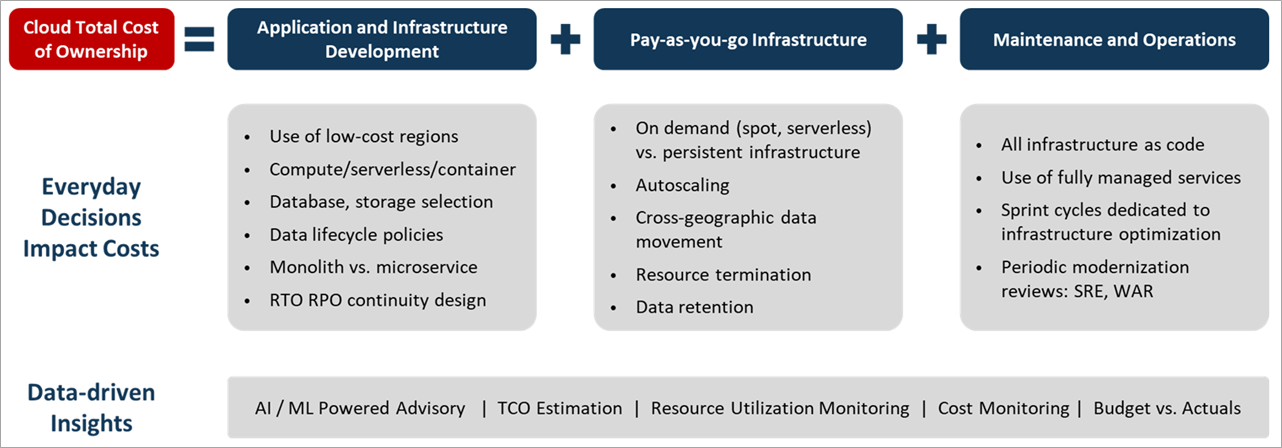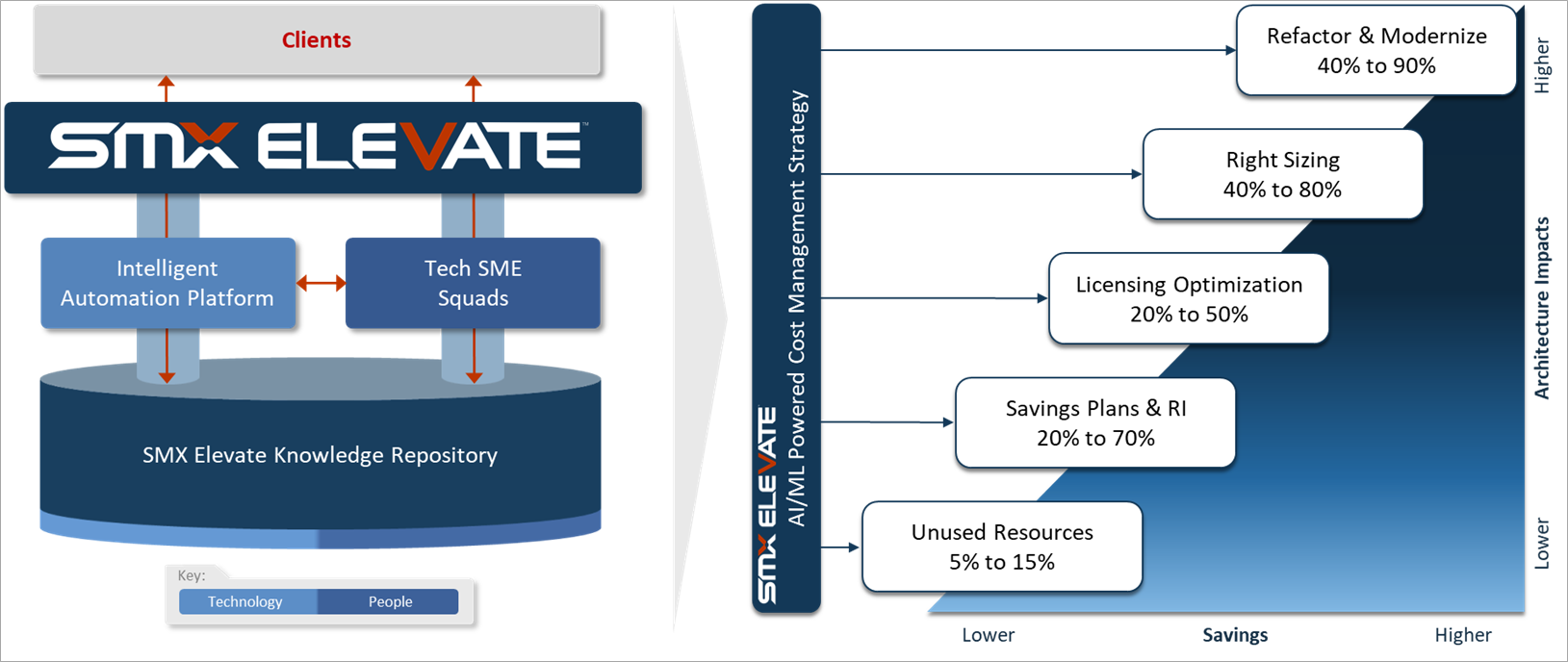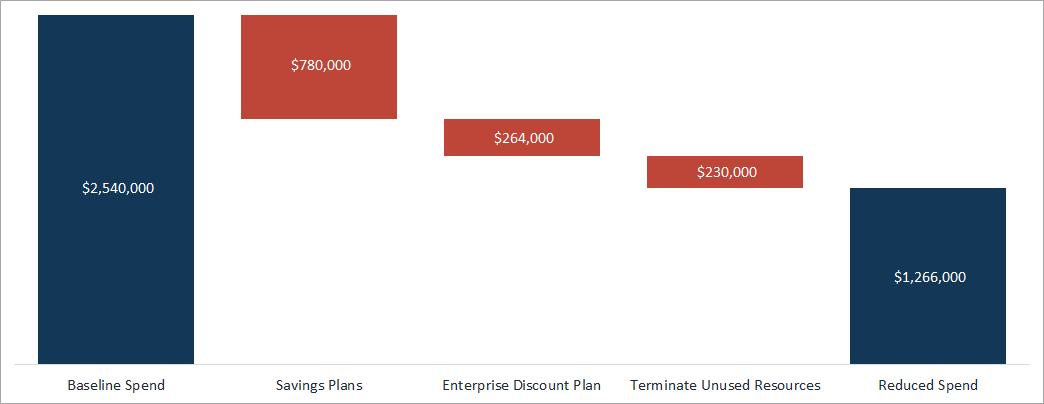AWS Partner Network (APN) Blog
Best Practices from SMX for Improving Cloud ROI Through Data-Driven Decisions
By Todd Moniot, IT Strategy Consultant and Sr. Solution Architect – SMX
By Wasay Mabood, Partner Solutions Architect – AWS
 |
| SMX |
 |
Leveraging data-driven insights, teams developing and managing cloud applications and infrastructure can deliver solutions that provide better user experiences while reducing total cost of ownership (TCO).
When considering how to manage cloud cost, there are several primary paths that can be taken to lower TCO, both technical and non-technical. In this post, we discuss how leveraging data-driven analysis and tools can improve decisions that impact short- and long-term spend.
Key topics covered in this post includes:
- How to offset forecasted cloud spend through improved cost management practices.
- Primary paths for cloud spend optimization—FinOps, architecture, and licensing.
- Practical steps to improve everyday decision making affecting long-term spend.
- Key data points that impact the effectiveness of your cost management practices.
SMX is an AWS Premier Tier Services Partner and AWS Marketplace Seller that delivers scalable and secure solutions combined with the mission expertise needed to accelerate outcomes for enterprise and government IT transformation.
SMX works with some of the world’s largest and most complex organizations, many of which are keen to improve their return on cloud investment spend.
Why Cost Management is Important
Reducing cloud spend is more important than ever. Managing cloud costs has become a top, strategic priority for most IT executives as accelerated growth, high waste rates, and tighter budgets are forcing them to understand and improve cloud spend. Most organizations are spending more than they planned as a result of not fully realizing the cloud’s financial benefits.
Organizations are expected to maintain high cloud adoption growth (20%) through 2026. Meanwhile, rapid adoption is being achieved at the expense of optimization.
IT executives indicate optimizing resources and reducing cloud spend is a top priority, and rightfully so. Implementing cost management quick wins could reduce wasted spend by 15-25% while setting an enterprise goal to cap spend waste at 10% would bring attention to the need to avoid future spend waste.
Figure 1 – Importance of cloud cost management.
Many organizations are leaving a lot of money on the table by not optimizing their cloud cost management practices. SMX research has concluded that modernizing FinOps practices with a goal of capping waste spend to 10% would offset the majority of growth in cloud costs expected over the next three years.
To illustrate this, on a base of $1 million in spend, organizations could avoid $400,000 per year within three years through the implementation of quick wins and adoption of FinOps best practices. Cumulative savings over the three-year period would exceed $900,000, or more than 90% of the initial baseline.
Figure 2 – Offset spend growth with improved FinOps practices.
Primary Paths to Optimize Cloud Spend
There are three primary paths to optimize cloud spend–FinOps, architecture, and licensing.
FinOps
On the non-technical side, we have financial operations, or FinOps. Most FinOps practices—like reserved instances and savings plans—can reduce cloud spend without impacting applications.
Other FinOps practices can be changed quickly, but they require working with application owners to realize the benefits. For example, changing a record retention policy from 11 years to 7 years would reduce storage spend, but application owners need to retire older archives to realize the savings.
Architecture
On the technical side, we have architecture. One of the most sustainable ways to optimize total cost of ownership is to reward cost to value decision making.
Embedding TCO analysis tools in solution design stages engrains cost factors into teams selecting infrastructure in support of their applications. Conducting periodic site reliability engineering (SRE) assessments and well-architected reviews identify service duplication, overprovisioned infrastructure, and underutilized resources.
Teams should set aside at least one sprint cycle per quarter to modernize infrastructure and reduce technical debt.
Licensing
Licensing optimization often requires a combination of non-technical and technical solutions. For example, renegotiating contracts with vendors doesn’t require architectural changes, but retiring Oracle licenses would require application owners to replace their databases.
Figure 3 – Primary paths to reduce cloud spend.
Data-Driven Innovations Simplify Cost Management
Four key trends are lining up like ducks in a row to help organizations better understand cloud spend and apply new, data-driven capabilities to realize cost savings.
- Strategic cost management
- Artificial intelligence-powered advisory
- Software asset management tools
- DevSecFinOps
Figure 4 – Innovations are lining up to simplify cost management.
Strategic Cost Management
The adaptation of strategic cost management practices is a powerful tool that organizations have used to improve profitability and liquidity. In the IT space, this has historically been applied to reduce maintenance spending and increase money available for innovation.
For decades, IT cost management strategies and processes have been refined to optimize complex financials for capital intensive, on-premises data centers. Adopting cloud requires new, fundamentally different cost management practices that align with cloud’s pay-as-you-go model.
Cost management strategies facilitate this transition by exploring best practices, identifying gaps, and developing new capabilities. The three main objectives are:
- Improve deep transparency in cloud spend.
- Develop targeted programs that reduce spend.
- Create behaviors that are sustainable over time.
AI-Powered Advisory Tools
A growing list of out-of-the-box artificial intelligence (AI) and machine learning (ML)-powered advisory tools are making it easier to explore optimization opportunities beyond just reserved instances and compute optimization.
Cloud native tools—such as AWS Cloud Financial Management and AWS Cost Explorer—combined with third-party tools like including CloudHealth and Anodot provide mature, out-of-the-box optimization recommendations across diverse spend dimensions:
- Reserved instances and savings plans.
- Right-sizing of compute, storage, and database.
- Resource spikes and sprawl prevention.
- Data storage, retention, and lifecycle management.
- Refactoring and modernization opportunities.
Software Asset Management Tools
Software asset management (SAM) tools have enhanced their cost advisory capabilities. In addition to identifying unused licenses, SAM tools are adding new capabilities to simplify processes to identify overlapping functionality, standardize vendors, reassign unused licenses, and right-size licensing during contract renewals.
A key focus area has been to identify overlapping functionality across on premises and cloud services, a highly useful feature for companies exiting data centers. Firewalls, traffic management, virtual machine hypervisors, and backup tools—to name a few—are evaluated for savings and spend reduction as users and traffic shift to the cloud.
SAM tools have traditionally supported end-user license optimization, and more recently they have added:
- Functionality duplication, emphasizing on-premises and CSP service duplication.
- Utilization of components and features within applications.
- Contract terms including entitlements and restrictions.
- Pricing model analysis (flat, consumption, tiered, user, feature, prod vs. non-prod).
- Business intelligence (BI) support for vendor negotiation, including renewal dates published pricing.
DevSecFinOps
Making a one-time spend reduction is easy, but sustaining spend through time is more difficult. The simplification of financial processes through automation and improved data accuracy is enabling cost management practices to be federated out into product owners, architects, and development teams.
By engraining cost frameworks and tools into the early stages of application and infrastructure solution design and decision making, organizations are putting the “Fin” in DevSecFinOps.
Improving Cloud ROI Through Data-Driven Decisions
Leveraging data-driven insights, technology teams can deliver solutions that improve outcomes and user experience while also reducing total cost of ownership. It’s important to remember that TCO includes development costs, pay-as-you-go infrastructure spend, and labor needed to operate and maintain cloud environments and workloads.
Figure 5 – Improving cloud ROI through data-driven decisions.
Application and infrastructure teams make everyday decisions that impact the costs of their solutions. Some decisions are immediate, like overprovisioning a server instance or failing to terminate unattached Amazon Elastic Block Store (Amazon EBS) volumes. These costs show up immediately on team dashboards and shortly after on the next bill.
Other decisions have longer term implications and are not as transparent. For example, launching an autoscaling group of persistent servers for applications that are accessed infrequently or with unpredictable demand can cost far more than serverless, when all lifecycle costs are considered.
Data-driven insights and tools can help development teams optimize decisions by incorporating cost considerations early in solution design.
SMX FinOps
SMX regularly work with clients to develop cost management strategies and targeted programs that deliver and sustain significant savings on their total cloud spend. SMX Elevate FinOps engagements are delivered through outcome-based pricing and pay for themselves, typically in the same year.
SMX Elevate’s approach accelerates cloud spend savings through a unique combination of highly certified tech experts, AI-powered intelligent automation, and an extensive knowledge repository that captures and curates decades of experience delivering successful digital transformation and operating complex, highly-regulated cloud workloads.
Elevate is a technology-enabled, outcome-based approach to solving business challenges. SMX Elevate FinOps delivers value via a transparent, outcome-based pricing model that shares risks and rewards.
Figure 6 – SMX FinOps is key service in the Elevate approach.
“Non-Technical” FinOps Improvements
SMX helps clients improve FinOps practices and achieve significant TCO savings. Working with a recent software company in the construction industry, SMX developed practices to regularly review and optimize savings plans and reserved instances.
The team introduced a process that leverages CloudHealth alerts to identify unused resources and integrates them with ServiceNow to create ITSM tickets for operations technicians to resolve. Without impacting applications or architecture, SMX was able to deliver more than 50% savings on their total cloud spend.
Figure 7 – SMX FinOps delivers significant cost savings.
“Technical” Architecture Improvements
Working with another organization, SMX is assisting with the modernization of a major application as part of a cloud migration. A thorough migration assessment identified numerous servers with low utilization (2-40%), and a well-architected review with application owners identified opportunities to improve cost and performance by adopting alternative compute services.
Infrequently-used application services were re-platformed (“lift-tinker-and-shift”) into AWS Lambda, while others were right-sized and established as autoscale groups. The result was a 90% reduction in direct annual spend the application owners were able to allocate to new features.
Figure 8 – Adopting AWS cloud-native services reduces TCO.
Begin Your Cost Management Journey
Considering the capabilities needed to deliver and sustain cost savings, where do you begin? SMX recommends starting with 10 practical steps that are easily achievable over the next 6-12 months. These steps would deliver quick wins and lay the foundation for longer term benefits as well.
10 practical steps to begin your cloud cost management journey:
- Formalize a cloud cost management strategy.
- Establish a 10% waste cap.
- Optimize savings plans and reserved instances.
- Identify software and licenses that can be reduced or retired.
- Apply ROI framework to vendors.
- Reevaluate on-premises vendors before using them in the cloud.
- Dedicate sprint cycles to optimize existing infrastructure.
- Review architecture for spend reduction opportunities.
- Engrain cost tools and frameworks into solution design.
- Reward cost to value decision making.
Conclusion
Accelerated cloud adoption will continue to drive 20% growth through 2026. Delivering FinOps practices and AI-powered tools that cap waste spending to 10% would offset the majority of the forecasted growth.
Contact SMX to start your cloud cost management journey and take practical steps to reduce and sustain your total cost of ownership. You can also learn more about SMX in AWS Marketplace.
Resources:
- Cloud financial management with AWS
- Get started with the AWS Well-Architected Tool
- Cloud financial management with CloudHealth from VMware
- Understand and control your cloud costs with Anodot
SMX – AWS Partner Spotlight
SMX is an AWS Premier Tier Services Partner that delivers scalable and secure solutions combined with the mission expertise needed to accelerate outcomes for enterprise and government IT transformation.








